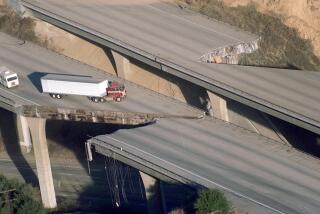L.A.’s many dangerous faults pose challenge for earthquake early warning system

Los Angeles Mayor Eric Garcetti explains how to use the new ShakeAlertLA app, available for Android and iOS devices.
Earthquake early warning systems have been part of life in metropolises like Tokyo, Taipei and Mexico City for years.
But bringing the technology to California, where numerous faults crisscross the region, proved to be a complex and time-consuming undertaking.
The faults that produce Japan and Mexico’s largest earthquakes are quite distant from their biggest cities, but the longest faults in California are much closer to urban centers like Los Angeles and San Francisco. That required the installation of more sensors and sophisticated software to detect shaking and send alerts.
The further a quake’s epicenter is from cities, the more warning residents there can receive — perhaps a minute for a temblor that begins more than 100 miles away. But quakes centered much closer could leave time for only a few seconds of warning, requiring the technology to render almost instantaneous decisions to be helpful.
“Here, especially in Los Angeles, where many of the faults are right under our feet, we need to be as fast as possible with a warning,” said John Vidale, professor of seismology at USC. “We really need to tune our systems for speed.”
First in the nation
Los Angeles this week became the first city in the U.S. to offer quake alerts to the general public, making them available in an app for Android and iOS devices. It uses data from the U.S. Geological Survey, which has been building an early warning system for the entire West Coast. Officials hope to eventually offer alerts across California, Washington and Oregon.
It’s taken decades to get to this point, with some wondering why California was so far behind. There were several reasons for this, including battles for funding. But scientists said it also took time to build a system that would work for California’s unique geography.
Mexico’s early warning system has fewer underground sensors because its largest quakes often are centered far from Mexico City. By contrast, California’s system has more than 600 sensors, and officials say they need to add 500 more. One of the biggest seismic threats to California is the mighty San Andreas fault, which runs for hundreds of miles. Sensors are needed all along that route, in rural and urban areas alike.
Earthquake warnings work on a simple principle: Seismic shaking travels at the speed of sound through rock — which is slower than the speed of today’s communications systems. Sensors that detect a big earthquake that starts at the Salton Sea and has begun to travel up the San Andreas fault could sound an alarm in Los Angeles, 150 miles away, before strong shaking arrived in the city, giving Angelenos perhaps more than a minute to prepare.

BART has tested the ShakeAlert system, designed to trigger trains to stop in the event of an earthquake, in Oakland.
A warning time of a few seconds can save lives, allowing utilities to turn off large high-pressure fuel lines, doctors to stop surgeries, transit agencies to slow trains and schoolchildren to shelter under desks.
Learning from shortcomings
Scientists said they’ve also tried to learn from shortcomings in other countries’ systems.
All earthquakes start the same way — small — and it can be difficult for conventional seismic instruments to measure extremely large earthquakes. Japan’s system could only initially calculate the 2011 earthquake as magnitude 8.1; in fact, the earthquake ended up being 32 times stronger, producing enough energy that it was calculated as magnitude 9.1.
As a result, a big problem was that the first estimates of tsunami heights sent before communication lines were cut off were too low — about 30 feet; actual tsunami heights were recorded as high as 100 to 130 feet, Vidale said.
To deal with this problem, scientists working on the USGS system for the West Coast have built in two new advances.
First, based on science developed by Caltech professor Tom Heaton and his students, they’ve been able to work out a computer algorithm that tracks a seismic event as it grows from a baby quake to something much larger. Japan’s system in 2011 initially calculated the size of that earthquake based only on the seismic activity at a single point in the earth, rather than continuing to track the quake as a progressively bigger area of faults moved.
Watching growth in real time
Watching a quake as it progresses is key. A hypothetical magnitude 6 earthquake that begins and ends in the Salton Sea, more than 130 miles from downtown Los Angeles as the crow flies, would cause little shaking in the state’s most populous city.
But if that baby quake continued to grow into a monster magnitude 7.8, relieving centuries of accumulated tectonic strain by moving along the San Andreas fault toward the northwest for 180 miles, past Palm Springs and San Bernardino and into the San Gabriel Mountains, downtown L.A. would be hit much harder by fresh waves generated much closer to the city center, as little as 35 miles away.

“Our approach is to actually track the earthquake itself and send out what the progression of the earthquake looks like,” Heaton said. “It’s probably the only existing system in the world that sends out updates of the estimates of the rupture dimension of an ongoing earthquake.”
Second, the USGS system incorporates the use of GPS sensors when calculating the size of an earthquake. Conventional seismic sensors, which measure ground acceleration, aren’t reliable for earthquakes greater than magnitude 7.5.
Say a major earthquake will hit in seconds. How do you protect yourself? »
Thursday’s official unveiling of the ShakeAlertLA app, which was quietly made available on New Year’s Eve for free download, was presented by Los Angeles Mayor Eric Garcetti, who pledged in his State of the City address in April 2017 to deploy an earthquake early warning system to the city by the end of 2018. The program works on phones served by any carrier.
The app, which currently works only for users physically in Los Angeles County, gives users warnings based on their geographic location tracked by their phone.
Garcetti said he’d be open to accepting requests from other counties interested in being served by the ShakeAlertLA system.
‘We stepped forward’
“Somebody had to develop it. We stepped forward and we did,” said Garcetti, who has made earthquake safety a priority as mayor. “Here in Los Angeles, we push those limits in technology…. Los Angeles is where the world comes to innovate.”
The city spent $300,000 on the app, which was created by AT&T after the company won a contract that was put out for competitive bids. The bill was footed by the nonprofit Annenberg Foundation, which contributed $260,000, and $43,000 from a nonprofit established by Garcetti, called the Mayor’s Fund for Los Angeles, which accepts donations to fund local civic programs.
After its initial year, the city will need to begin paying the bills to maintain the app: $20,000 a year for web services and $27,000 annually for maintenance.
The programming is owned by the taxpayers and is open source, meaning that other cities and counties are free to take ShakeAlertLA’s code and use it for their own systems.
The app is currently set to sound an alarm only for magnitude 5 and higher earthquakes or those that cause at least light shaking, a level of ground movement that begins to affect public safety. There are still some bugs, including that the alarm won’t sound if users have their phones set to silent.
A broader release
Warnings could soon be made more broadly available statewide. Josh Bashioum, founder of the Santa Monica company Early Warning Labs, which has been closely working with the USGS, said he hopes to release a beta version of his app, QuakeAlert, to as many as 100,000 test users across California soon.
The system won’t be perfect, especially in its first few years. As residents of Japan, Mexico and other places that already have the alerts have learned, the system comes with false alarms and missed warnings. And early warnings probably won’t be possible for users at the epicenter of a quake.
Warnings through Amber Alert-style text messages won’t come immediately »
A prototype system has proved successful in many recent minor and moderate California quakes, notably the 2014 magnitude 6 earthquake that hit Napa, giving San Francisco eight seconds of warning. Earlier that year, scientists in Pasadena got six seconds of warning when a magnitude 5.1 earthquake hit La Habra.
After years of skepticism or opposition, federal and state elected officials have moved to support the system. The state budget that passed in 2018 authorized an additional $15 million to build out the remaining sensors that are needed for California to have a complete warning system, expected to be finished by 2021. In the last budget approved by the federal government in March, the system was allocated $22.9 million, more than double the amount that the system got in the previous year’s budget.
Twitter: @ronlin
More to Read
Start your day right
Sign up for Essential California for news, features and recommendations from the L.A. Times and beyond in your inbox six days a week.
You may occasionally receive promotional content from the Los Angeles Times.







